For many of us, images of police brutality during the G20 protests brought back memories of a previous government's attempt to deploy trained riot police to defeat legitimate protest - the iconic battle of Orgreave during the 1984-85 miners' strike. The subsequent exposure of police tactics in confronting 500 miners picketing the coking plant near Rotherham and the misrepresentation of the event by the national media may mean we are now more sceptical about the policing of protest.
Shafted reflects upon the near-blanket bias of the national media during the miners' strike, symbolised by BBC news' reversal of the sequence of events at Orgreave to suggest that picketing miners attacked the police.
Published by the Campaign for Press and Broadcasting Freedom for the 25th anniversary of the strike, this edited volume offers a somewhat fragmented collection of personal recollections and analyses of its representation and aftermath. In his contribution Michael Bailey argues that there is still an ideological battle, defined by competing cultural representations of the strike, which resonates in the national collective consciousness reflected, for example, in the Turner Prize-winning artist, Jeremy Deller's, re-enactment and repoliticisation of Orgreave.
Shafted "looks back in anger" at the defeat of the strike and its impact upon the mining communities. Yet it includes powerful accounts of union and political solidarity: the refusal of print workers at The Sun to allow the newspaper to publish a doctored photo of Arthur Scargill appearing to make a Nazi salute; rail workers blocking the delivery of coal to the Orgreave coking plant; attempts by the alternative media to counter the distortions of the mainstream coverage; and the work of the local miners' support groups - all in the face of the reluctance of much of the Labour Party and the Trades Union Congress to mobilise support for the strikers.
Scargill's prediction of widespread closures was derided by the media during the strike, but proved to be overcautious. Shafted records the legacy of the defeat and the devastation of communities blighted by high levels of unemployment, poverty and antisocial crime, with a generation turning to drugs: "In the pit villages they used to say that coal ran in their blood; 20 years later it's heroin."
The volume acknowledges the central importance of Women Against Pit Closures; Hilary Wainwright argues that for women in mining communities the strike allowed for the expression and mobilisation of their existing and interwoven personal and political concerns. She describes how in the strike's aftermath these women have moved into Labour Party activism, but also into community or voluntary activity where their social and political values underlie both their unpaid and paid welfare work. For Wainwright their simultaneous concern with both daily social life and wider political change overcomes the industrial and political division that characterises the labour movement, but which are actually "two essential dimensions of social change".
For Dave Feickert, the National Union of Mineworkers' former research officer, the Tory Government's attack upon the miners represented not only the "wilful destruction" of mining communities, but also of the "nation's strategic energy resource". Nicholas Jones, a former BBC correspondent, shows how the tripartite relationship between the NUM, the National Coal Board and government that existed before the strike allowed for strategic discussions on the future utilisation of coal, which could have helped address the challenges of climate change - something that the privatisation of energy has made virtually unthinkable. The expansion of the coal industry based upon carbon-capture technology is one solution, although not uncontroversial, as Scargill's appearance at the Camp for Climate Change outside the Kingsnorth coal-fired power station, in August 2008, demonstrated.
A number of journalists reflect on their role in the strike and are troubled, as Jones admits: "I got ensnared by the seeming inevitability of the Thatcherite story line that the mineworkers had to be defeated in order to smash trade union militancy." He suggests that perhaps the news media should own up to a collective failure of judgment, and concludes that while the role of the media was not decisive to the final outcome of the strike, if its "near-unanimous narrative had not been so hostile to the NUM and had done more to challenge government then Thatcher may have been forced to reach a negotiated settlement during the initial phase of the dispute".
In contrast, the media's sympathetic treatment of the miners and opposition to the closure and privatisation of the surviving pits in the decade after the strike is a bitter reminder of the condescension of history - by this point it was too late. One legacy of the defeat of the strike is the current growth in attraction to the British National Party in previously radicalised communities - the NUM's lesson in the importance of acting at the right time could not be more instructive.
Shafted: The Media, the Miners' Strike and the Aftermath
Edited by Granville Williams
Campaign for Press and Broadcasting Freedom, 208pp, £9.99
ISBN 9781898240051
Published 1 March 2009
Register to continue
Why register?
- Registration is free and only takes a moment
- Once registered, you can read 3 articles a month
- Sign up for our newsletter
Subscribe
Or subscribe for unlimited access to:
- Unlimited access to news, views, insights & reviews
- Digital editions
- Digital access to THE’s university and college rankings analysis
Already registered or a current subscriber? Login
